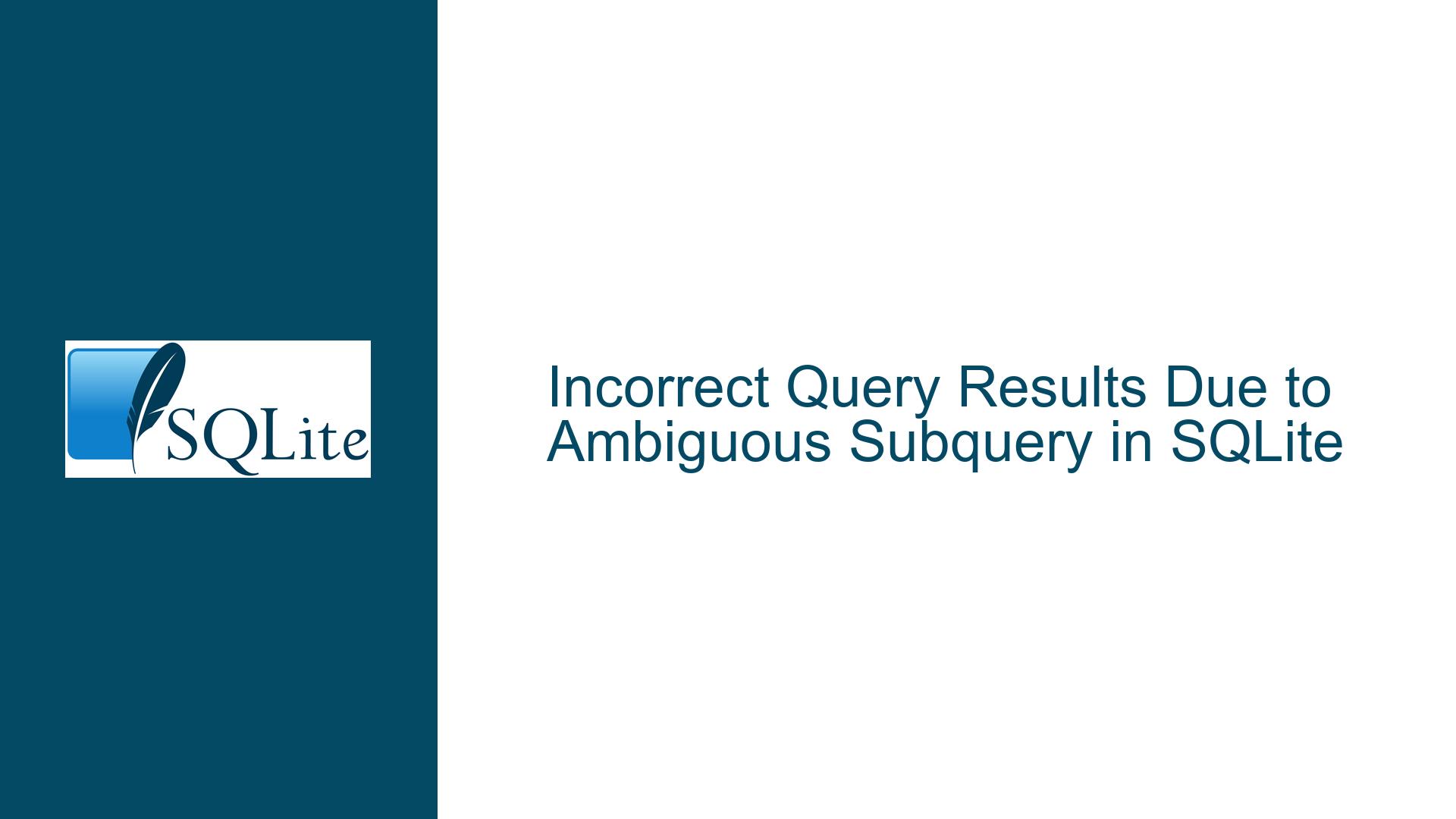Incorrect Query Results Due to Ambiguous Subquery in SQLite
Ambiguity in Subquery Results Leading to Inconsistent Output
The core issue revolves around a SQLite query that produces inconsistent results due to an ambiguous subquery. The query involves a nested subquery within a join, and the ambiguity arises from the lack of a deterministic order in the subquery’s results. This ambiguity causes the query to return different results depending on the order in which rows are processed by SQLite. The problem is exacerbated by the fact that the subquery returns multiple rows with different values, and the query does not specify how to handle these multiple rows. As a result, the query can return different results even when the underlying data remains unchanged.
Root Cause: Ambiguous Subquery Without Deterministic Ordering
The root cause of the issue lies in the subquery used in the inequality condition. Specifically, the subquery (select ref_5.c2 as c0 from t1 as ref_7 where ref_4.c3 <> ref_7.c3) returns multiple rows with different values. Since SQLite does not guarantee the order of rows returned by a subquery unless explicitly specified, the result of the subquery can vary. This variability leads to different outcomes when the subquery’s result is compared against ref_0.c2.
In the given query, the subquery returns two distinct values: 24 and 2147483647. Depending on which value is returned first, the comparison ref_0.c2 <= (subquery result) will yield different results. If 24 is returned first, the condition may evaluate to true, whereas if 2147483647 is returned first, the condition may evaluate to false. This non-deterministic behavior is the primary cause of the inconsistent query results.
Resolving Ambiguity with ORDER BY, LIMIT, or Aggregate Functions
To resolve the ambiguity in the subquery, you can employ one of several strategies:
Using ORDER BY and LIMIT: By adding an
ORDER BYclause to the subquery and limiting the result to a single row usingLIMIT 1, you can ensure that the subquery returns a deterministic result. For example, you could modify the subquery to(select ref_5.c2 as c0 from t1 as ref_7 where ref_4.c3 <> ref_7.c3 ORDER BY ref_5.c2 LIMIT 1). This ensures that the subquery always returns the smallest or largest value, depending on theORDER BYclause.Using Aggregate Functions: Another approach is to use an aggregate function such as
MIN()orMAX()to ensure that the subquery returns a single value. For instance, you could rewrite the subquery as(select MIN(ref_5.c2) from t1 as ref_7 where ref_4.c3 <> ref_7.c3). This approach eliminates the ambiguity by explicitly specifying that the subquery should return the minimum or maximum value from the set of possible results.Ensuring Consistent Data Handling: In some cases, the ambiguity may arise from the underlying data model or the way the query is structured. It is essential to ensure that the data model supports the intended query logic and that the query is written in a way that aligns with the data model. This may involve revisiting the schema design or restructuring the query to avoid ambiguous subqueries.
By implementing one of these strategies, you can eliminate the ambiguity in the subquery and ensure that the query returns consistent results. It is crucial to choose the approach that best aligns with the intended logic of the query and the underlying data model. Additionally, thorough testing should be conducted to verify that the modified query produces the expected results across different scenarios.
Detailed Explanation of the Query Structure and Ambiguity
To fully understand the issue, it is necessary to dissect the query structure and identify the points where ambiguity can arise. The query in question involves multiple joins and a nested subquery, which complicates the analysis. Let’s break down the query step by step:
Main Query: The main query selects rows from
t1where thewkeycolumn is less than or equal to the result of a subquery. The subquery is used in theWHEREclause of the main query, making it a correlated subquery.Subquery: The subquery itself involves a complex join structure. It joins
t0(aliased asref_4) with another instance oft0(aliased asref_5), which is left-joined with yet another instance oft0(aliased asref_6). The join conditions are based on thewkeyandc2columns.Ambiguous Condition: The ambiguity arises in the condition
ref_0.c2 <= (select ref_5.c2 as c0 from t1 as ref_7 where ref_4.c3 <> ref_7.c3). Here, the subquery returns multiple rows, and the comparison is made against the first row returned by the subquery. Since the order of rows is not guaranteed, the result of the comparison can vary.Impact of Ambiguity: The variability in the subquery’s result directly impacts the outcome of the main query. Depending on which value is returned first by the subquery, the main query may include or exclude certain rows from the result set. This leads to inconsistent results, as observed in the original discussion.
Detailed Analysis of the Data Model and Query Logic
To further understand the issue, it is essential to analyze the data model and the logic behind the query. The database consists of two tables: t0 and t1. The t0 table has columns wkey, pkey, c2, and c3, while the t1 table has columns wkey, c2, and c3. The query aims to retrieve rows from t1 based on a condition that involves a complex join and a subquery.
Data Model: The
t0table contains two rows with distinctpkeyvalues but the samewkeyvalue. Thec2andc3columns contain numeric values, including large integers and floating-point numbers. Thet1table contains a single row with awkeyvalue that is different from thewkeyvalues int0.Query Logic: The query logic involves comparing the
wkeycolumn oft1with the result of a subquery that joins multiple instances oft0. The subquery’s result is used in an inequality condition, which introduces ambiguity due to the lack of deterministic ordering.Potential Issues: The data model and query logic introduce several potential issues, including the possibility of ambiguous results due to the subquery’s non-deterministic behavior. Additionally, the use of large integers and floating-point numbers in the
c2andc3columns may lead to precision issues or unexpected behavior in comparisons.
Detailed Troubleshooting Steps and Solutions
To address the issue, follow these detailed troubleshooting steps:
Identify the Ambiguous Subquery: The first step is to identify the subquery that is causing the ambiguity. In this case, the subquery
(select ref_5.c2 as c0 from t1 as ref_7 where ref_4.c3 <> ref_7.c3)is the source of the ambiguity. This subquery returns multiple rows, and the comparisonref_0.c2 <= (subquery result)is non-deterministic.Determine the Desired Behavior: Next, determine the desired behavior of the subquery. Should it return the minimum value, the maximum value, or a specific value based on some ordering? Understanding the intended logic is crucial for resolving the ambiguity.
Modify the Subquery: Based on the desired behavior, modify the subquery to ensure deterministic results. This can be achieved by adding an
ORDER BYclause and aLIMIT 1clause or by using an aggregate function such asMIN()orMAX(). For example, if the goal is to compareref_0.c2with the minimum value returned by the subquery, modify the subquery as follows:(select MIN(ref_5.c2) from t1 as ref_7 where ref_4.c3 <> ref_7.c3).Test the Modified Query: After modifying the subquery, test the query to ensure that it produces the expected results. Run the query multiple times to verify that the results are consistent and that the ambiguity has been resolved.
Review the Data Model: If the issue persists, review the data model to ensure that it supports the intended query logic. Consider whether the schema design aligns with the query requirements and whether any changes to the schema are necessary to avoid ambiguity.
Optimize the Query: Finally, optimize the query for performance. Ensure that the query is efficient and that it does not introduce unnecessary complexity or overhead. Use indexes, if necessary, to improve query performance.
By following these steps, you can resolve the ambiguity in the subquery and ensure that the query returns consistent results. It is essential to thoroughly test the modified query and to review the data model to ensure that it supports the intended query logic. Additionally, consider optimizing the query for performance to ensure that it runs efficiently in a production environment.
Conclusion
The issue of incorrect query results due to an ambiguous subquery in SQLite can be resolved by ensuring that the subquery returns deterministic results. This can be achieved by adding an ORDER BY clause and a LIMIT 1 clause or by using an aggregate function such as MIN() or MAX(). It is crucial to understand the intended logic of the query and to modify the subquery accordingly. Additionally, thorough testing and review of the data model are essential to ensure that the query produces consistent and accurate results. By following the detailed troubleshooting steps outlined above, you can resolve the ambiguity and ensure that your SQLite queries perform as expected.






